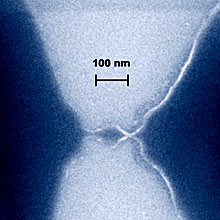New Graphene Transistors Show Promise
Researchers at the University of Manchester have announced a single-electron transistor made out of graphene, a single sheet of graphite only one atom thick. The researchers’ device, which is the first single-electron transistor to operate at room temperature, offers evidence that graphene is a promising alternative to silicon, which, in the coming decades, is expected to reach its physical limits as a material for making ever-smaller transistors.

Engineers in the semiconductor industry expect that by 2025, the features on chips will need to shrink to about 15 nanometers, from today’s 45-nanometer size, but few people expect that silicon is the material that can lead the charge. “I don’t know how they’re going to do this,” says Andre Geim, professor of physics at the University of Manchester and lead researcher on the work. “Essentially,” he says, “the semiconductor road map sees a cul-de-sac in 2025.” Geim believes that graphene, however, “can extend beyond this cul-de-sac.”
The single sheet of graphite is a relatively new material that was first reported by Geim’s group in 2004. It is essentially an unrolled carbon nanotube–a tube made of a single sheet of graphite with a diameter of about a nanometer–which is also being explored as a material for transistors. A growing number of scientists are researching the material because it has an exceptionally useful electrical property: electrons can travel through the material quickly and without bouncing off atoms and scattering. This property, called ballistic transport, could make graphene useful for a range of applications, from making faster, smaller electrical devices to testing theories from a branch of physics called quantum electrodynamics.
When members of Geim’s group first announced their fabrication of graphene, they also demonstrated how it could be used to make a transistor. However, the early graphene transistors were impractical because electrical current would leak from them, making them inefficient.
“In recent years,” says Geim, “there’s been a drive to try to find a solution around this problem.” Some scientists have looked at using ribbons of graphene and placing them side by side to try to create artificial electrical properties that confine the current. But in this configuration, says Geim, the ribbons of carbon simply mimic the behavior of carbon nanotubes, and they don’t take full advantage of the properties of graphene.
The researchers’ new approach uses a transistor design known for years, called a single electron transistor, which funnels one electron through the transistor at a time. Single-electron devices based on this design usually consist of electrical contacts, called a source and a drain, that supply and collect the current, and a nanometer-size island of conducting material, called a quantum dot, in between the contacts.
When current is applied, explains Geim, an electron jumps from the source to the quantum dot, and then to the drain. Quantum dots can only accommodate the single electron, therefore “electrons flow one at a time, or not at all,” says Geim. “By changing the charge of the central dot, you can control the flow of electrons through it.”
The problem with most single-electron transistors, says Geim, is that materials used for the quantum dots aren’t stable enough at room temperature. When most metals are shrunk to the size of quantum dots–about two to three nanometers wide–they become fragile and move around, “like a droplet of liquid on a hot plate,” he says. Graphene quantum dots, however, are stable at room temperature and can even withstand high electrical current. “The most important part of our work,” Geim says, “is to demonstrate that graphene can be confined to a few nanometers in size.”
Still, manufacturing these transistors will be tough. In fact, there is no fabrication technique that can reliably produce three-nanometer-size quantum dots. Geim’s devices were made using electron-beam lithography, but most of the transistors didn’t have usable quantum dots. The researchers “had to rely on luck,” he says, to get the right-size dots–and thus usable transistors. However, Geim notes, as the semiconductor industry improves its fabrication techniques, graphene will benefit.
Geim’s work was published in the current issue of Nature Materials as part of a peer-reviewed article summarizing the state of graphene research. He does not intend to fully report his results for another six months. In the meantime, other groups are working on similar designs. Researchers at Georgia Institute of Technology, in Atlanta, led by Walter de Heer, a professor of physics, have been working to develop graphene transistors since 2001. The work is supported by Intel, and patents have already been issued for graphene-transistor designs.
Right now, graphene research is competitive, and it’s still not clear which approach will prevail. As graphene gains traction, engineers are enthusiastic about the possibilities of the material. “The recently developed graphene devices have created enormous excitement in the field,” says Ali Javey, professor of electrical engineering and computer sciences at the University of California, Berkeley. And he believes that after silicon, graphene will play an important role in electronics.
Keep Reading
Most Popular
Large language models can do jaw-dropping things. But nobody knows exactly why.
And that's a problem. Figuring it out is one of the biggest scientific puzzles of our time and a crucial step towards controlling more powerful future models.
How scientists traced a mysterious covid case back to six toilets
When wastewater surveillance turns into a hunt for a single infected individual, the ethics get tricky.
The problem with plug-in hybrids? Their drivers.
Plug-in hybrids are often sold as a transition to EVs, but new data from Europe shows we’re still underestimating the emissions they produce.
Stay connected
Get the latest updates from
MIT Technology Review
Discover special offers, top stories, upcoming events, and more.